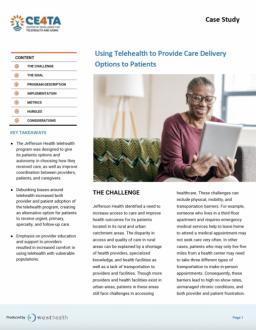Using Telehealth to Provide Care Delivery Options to Patients
Expanding Access and Reducing Barriers Through Innovative Telehealth Solutions
January 30, 2024CONTENT
THE CHALLENGE
THE GOAL
PROGRAM DESCRIPTION
IMPLEMENTATION
METRICS
HURDLES
CONSIDERATIONS
KEY TAKEAWAYS
The Jefferson Health telehealth program was designed to give its patients options and autonomy in choosing how they received care, as well as improve coordination between providers, patients, and caregivers.
Debunking biases around telehealth increased both provider and patient adoption of the telehealth program, creating an alternative option for patients to receive urgent, primary, specialty, and follow-up care.
Emphasis on provider education and support to providers resulted in increased comfort in using telehealth with vulnerable populations.

THE CHALLENGE
Jefferson Health identified a need to increase access to care and improve health outcomes for its patients located in its rural and urban catchment areas. The disparity in access and quality of care in rural areas can be explained by a shortage of health providers, specialized knowledge, and health facilities as well as a lack of transportation to providers and facilities. Though more providers and health facilities exist in urban areas, patients in these areas still face challenges in accessing healthcare. These challenges can include physical, mobility, and transportation barriers. For example, someone who lives in a third-floor apartment and requires emergency medical services help to leave home to attend a medical appointment may not seek care very often. In other cases, patients who may only live five miles from a health center may need to take three different types of transportation to make in-person appointments. Consequently, these barriers lead to high no-show rates, unmanaged chronic conditions, and both provider and patient frustration.
COVID-19 uncovered untapped opportunities to augment care for all Jefferson Health patients. Leadership at Jefferson Health aimed to give their patients options and autonomy in choosing how they received care, as well as improve coordination between providers, patients, and caregivers. To do this, the health system bolstered its telehealth service line to better leverage resources and provide greater optionality to patients seeking care. Instead of patients traveling for hours to an in-person healthcare appointment, they could facilitate a telehealth visit for an expanded range of needs.
THE GOAL
The health system has worked hard to improve its telehealth workflows and education. The telehealth program’s primary objectives are to remove barriers to care, improve patient outcomes, and promote inclusivity. Jefferson Health’s leadership wanted to develop best practices to promote high adoption rates and seamless, integrated telehealth care delivery. “We wanted to create access to care without barriers, without walls. We wanted to find other ways, other tools for the toolkit, that would allow us to meet people where they wanted to be met,” says Frank Sites, MHA, BSN, RN, Vice President of Connected Care Operations at Jefferson Health.
PROGRAM DESCRIPTION
JeffConnect, the platform they use for video visits, is powered by Teledoc. It includes over 300 configurations unique to Jefferson Health’s demographics. JeffConnect is used enterprise-wide, serving its 18-hospital system, including over 50 outpatient and urgent care locations in Pennsylvania and New Jersey.
The telehealth program offers three visit types that expand the range of conditions that can be evaluated and treated virtually: on-demand visits, scheduled visits, and e-visits. The program primarily leverages on-demand and scheduled services with the latter making up the majority of the telehealth visits type.
On-Demand/Unscheduled Visits
On-demand visits were established to serve patients in the community needing urgent or unscheduled care from a provider. These visits address the immediate needs of the patient and support the identification of what might be the next actionable step in the patient’s health care journey. On-demand services are available 24/7.
On-demand services are organized into different levels depending on patient acuity. This is illustrated by what Jefferson Health calls “The Wheel” (Figure 1). The categories were determined by identifying predominant types of service delivery that were provided across the system. The Wheel demonstrates where telehealth fits across the continuum and provides guidance on matching patient acuity level with the appropriate level of telehealth service.
Scheduled Visits
Scheduled visits encompass both ambulatory and inpatient primary and specialty care. Reasons for these visits can include discussing follow-up care or recovery progress after procedures or illness. The majority of scheduled visits occur as outpatient ambulatory encounters with patients’ established primary care providers or specialists. The program completes over 250,000 scheduled visits annually.
E-visits
E-visits are provider-to-provider visits that can be completed synchronously or asynchronously.
Jefferson Health’s robust telehealth service offerings demonstrate the system’s commitment to permanently integrating telehealth as another layer of care. Mr. Sites emphasized this by noting, “We see telehealth as merely another way that our patients can obtain healthcare in a manner that works for them. Giving patients an additional possibility for how to obtain their care is yet another tool in the healthcare toolbox that patients, families, and providers can leverage.”
Figure 1. The Wheel

IMPLEMENTATION
Initial implementation of the telehealth service line involved hiring seven or eight telehealth coordinators who would visit inpatient units and set up video calls between family members and hospital providers. Coordinating family and physicians in this setting proved difficult, however, and the program was mostly unsuccessful. Jefferson Health pivoted their operations to increase engagement and better prepare both patients and providers. It was decided that telehealth needed to become more ubiquitous, and thus was integrated into every ambulatory practice including primary and specialty care.
To support these efforts and help ensure access to underserved populations, telehealth coordinators were tasked with calling each patient scheduled for telehealth and completing test visits via the JeffConnect telehealth platform. They asked probing questions to understand existing barriers - including physical, cognitive, technology, and literacy - that individuals may experience and what resources were available to them, such as family members or other caregivers, to assist with a telehealth visit. These test calls helped to identify what accommodations patients needed and what resources could be leveraged to ensure a successful telehealth encounter. This allowed for improved access to telehealth.
In 2019, they conducted approximately 60 unique telehealth visits per day. When the COVID-19 pandemic reduced access to in-person visits, the JeffConnect program grew exponentially, to approximately 100,000 visits per month, or over 3,300 visits per day. To track the quality of virtual visits, Jefferson Health enabled providers to rate and provide feedback about the telehealth visit directly through EPIC, an electronic medical record system (EMR).
HURDLES
Jefferson Health realized focusing on providing education and support to providers would result in higher adoption of telehealth. Seventy-four percent of patients indicated they learned about telehealth from their provider. However, feedback from the system’s quality improvement efforts illustrated that some providers were struggling to use telehealth. In response to this, Jefferson Health deployed strategies to remove barriers and biases that discouraged telehealth use generally and with certain patient groups like older adults. “Our job was to debunk the myths,” says Mr. Sites, “and make it so that patients and providers would see that [telehealth] is easy to do and easy to use.”
Example Bias: In-person visits are the gold standard and telehealth is confusing, complex, and difficult to use.
Physicians struggled with the concept of providing care without being able to physically assess their patients. To address misconceptions about the utility of telehealth, Jefferson Health heavily invested in provider education on how to successfully perform a comprehensive virtual visit. Providers received in-person and web-based training on telehealth best practices, regulatory and compliance aspects, risk management, as well as modules on how to effectively conduct physical exams using telehealth. Providers also completed practice visits. To encourage program buy-in and success, measurable goals were set for completing video visits for every provider. These goals were scaled up as providers reached them.
Additionally, the telehealth coordinator role expanded to assist providers in addition to patients. They began visiting with providers who were experiencing the most difficulty and working one-on-one to provide education and find new opportunities for telehealth implementation. “The telehealth coordinators played a large role [by] going into the clinical practices, working with the practice managers, working with the scheduling teams, and looking for other avenues to lean the doctor in towards a telehealth visit, as opposed to doing what was tried and true,” says Mr. Sites.
In addition to optimizing training and workflows for telehealth, leadership worked to broaden the understanding of what types of visits are most appropriate to perform virtually and focused on making the platform simple, user-friendly, and integrated with the EMR. This was essential for both provider adoption and for promotion of telehealth to patients. “If we didn’t make [providers] feel comfortable with it [platform], then they were never going to tell their patients about it,” says Mr. Sites.
To make it easy and simple for patients, the platform has multiple options for connecting to the video visit. Patients can connect through the JeffConnect app on their smartphones or tablets, or if they don’t want to download an app, they can connect using a web browser. Additionally, there is a “connect tab” built into the EMR that providers can push to send an SMS link directly to patients’ phones.
Example Bias: Patients want to come into the office.
When patients were offered a choice, in-person care wasn’t always their preferred option. Telehealth removed a significant barrier to accessing care, especially for older adults, individuals with disabilities or who have transportation limitations, and those who live far from health centers. Having options to easily get their health needs met was what patients wanted. Educating providers on the benefits that telehealth provides to patients, and that patients appreciate the choice to access care from anywhere, helped increase provider adoption.
Example Bias: Older adults will struggle with telehealth.
Some providers believed that telehealth was too challenging for older adults to navigate. While some individuals—of all ages—did struggle with telehealth, or preferred to receive in-person care, Jefferson Health found that many older patients were very successful conducting video visits. Telehealth has the benefit of reducing the burden on family and caregivers to assist with transportation to and from appointments for older-adult loved ones.
To address provider apprehension, telehealth coordinators were deployed to complete test visits with patients and offered education and technical assistance. The coordinators would then report patients’ readiness to their providers. This communication reduced the biases and accompanying discomfort that providers had which led to more telehealth engagement with older patients and a more inclusive program.
METRICS
Currently, the JeffConnect telehealth program conducts approximately 1,000 appointments per day, Monday through Friday. This equates to about 9% of ambulatory visits. On-demand telehealth services are highly effective with 80% of patient encounters needing no further care or follow-up. Of those remaining 20% of patients who are referred to the emergency department, two-thirds are admitted to the hospital validating the ability of the on-demand providers’ ability to accurately identify patients needing a higher level of care.
In the early stages of the telehealth program, metrics focused on telehealth visit volume as an indicator of success. However, the telehealth team discovered that visit volume told an incomplete story—there was only a small number of early adopters completing a majority of the telehealth visits. As the program evolved, the team changed what success meant. To Jefferson Health, success now means a greater number of patients have access to this type of care delivery. Wide-scale adoption by providers is the key to achieving success because most Jefferson Health patients learn about telehealth from their providers. The team now tracks how many providers and clinical specialties are engaged in completing telehealth visits.
Additional metrics focus on how well telehealth is working for patients and providers. This is done through the daily “hiccup” reports, as well as patient ratings on their telehealth experience through Net Promoter Scores (NPS).
CONSIDERATIONS
Jefferson Health’s telehealth program is focused on increasing access to equitable and quality healthcare for all. Accessibility, equity, and quality are all foundation pillars in the movement towards age-inclusive telehealth. Their focus on increasing provider engagement and comfort with telehealth is an important aspect of promoting effective telehealth and ensuring all patients, regardless of age or ability, can benefit from it.
Mr. Sites emphasizes that their program’s success is attributed to:
Listening to providers and patients to understand what problem you are trying to solve
Providing proper education to providers to ensure comfort and acceptance of the telehealth program
Utilizing telehealth coordinators to troubleshoot issues, provide one-on-one education, and ensure usability and access
Ensuring the telehealth platform is easy to use
Seeing failures as opportunities to pivot and having a culture of continuous improvement
Removing biases about who may or may not be a good candidate for telehealth
To continue providing accessible care to older adults, Jefferson Health works to incorporate the Principles and Guidelines for Telehealth and Aging, developed by The Center of Excellence for Telehealth and Aging (CE4TA). The JeffConnect program team is consistently working to ensure the program is patient-centered, equitable and inclusive, and provides integrated and coordinated care following the Principles and Guidelines.
Join other organizations in signing the Pledge of Support towards a commitment to fostering age-inclusive telehealth practices. Visit The Center of Excellence for Telehealth and Aging to find out more about the Principles and Guidelines for Telehealth and Aging and add your name to the CET4A’s Pledge of Support.

For more information please visit:
ce4ta.matrc.org
About The Center of Excellence for Telehealth and Aging
West Health Institute (WHI), the University of Virginia (UVA) Department of Geriatrics, and the Mid-Atlantic Telehealth Resource Center (MATRC), partnered to create the Center of Excellence for Telehealth and Aging (CE4TA). CE4TA was established to advance the adoption of age-inclusive telehealth. It is a unique platform to foster a national discussion and movement to advance age-inclusive telehealth for older adults.
Downloads

Jefferson-Health-Case-Study_FINAL__LW-003-1.pdf
Download